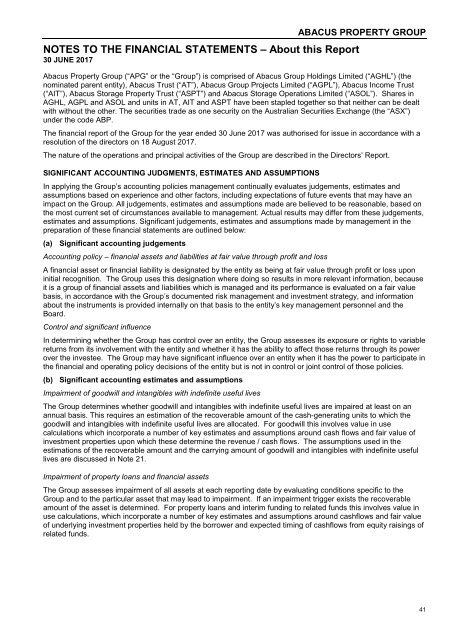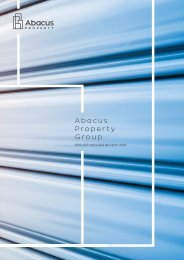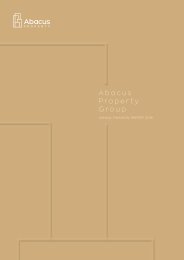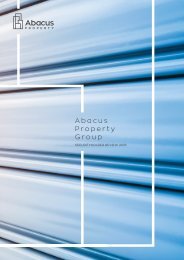Abacus Property Group – Annual Financial Report 2017
Abacus Property Group – Annual Financial Report 2017
Abacus Property Group – Annual Financial Report 2017
Create successful ePaper yourself
Turn your PDF publications into a flip-book with our unique Google optimized e-Paper software.
NOTES TO THE FINANCIAL STATEMENTS <strong>–</strong> About this <strong>Report</strong><br />
30 JUNE <strong>2017</strong><br />
ABACUS PROPERTY GROUP<br />
<strong>Abacus</strong> <strong>Property</strong> <strong>Group</strong> (“APG” or the “<strong>Group</strong>”) is comprised of <strong>Abacus</strong> <strong>Group</strong> Holdings Limited (“AGHL”) (the<br />
nominated parent entity), <strong>Abacus</strong> Trust (“AT”), <strong>Abacus</strong> <strong>Group</strong> Projects Limited (“AGPL”), <strong>Abacus</strong> Income Trust<br />
(“AIT”), <strong>Abacus</strong> Storage <strong>Property</strong> Trust (“ASPT”) and <strong>Abacus</strong> Storage Operations Limited (“ASOL”). Shares in<br />
AGHL, AGPL and ASOL and units in AT, AIT and ASPT have been stapled together so that neither can be dealt<br />
with without the other. The securities trade as one security on the Australian Securities Exchange (the “ASX”)<br />
under the code ABP.<br />
The financial report of the <strong>Group</strong> for the year ended 30 June <strong>2017</strong> was authorised for issue in accordance with a<br />
resolution of the directors on 18 August <strong>2017</strong>.<br />
The nature of the operations and principal activities of the <strong>Group</strong> are described in the Directors’ <strong>Report</strong>.<br />
SIGNIFICANT ACCOUNTING JUDGMENTS, ESTIMATES AND ASSUMPTIONS<br />
In applying the <strong>Group</strong>’s accounting policies management continually evaluates judgements, estimates and<br />
assumptions based on experience and other factors, including expectations of future events that may have an<br />
impact on the <strong>Group</strong>. All judgements, estimates and assumptions made are believed to be reasonable, based on<br />
the most current set of circumstances available to management. Actual results may differ from these judgements,<br />
estimates and assumptions. Significant judgements, estimates and assumptions made by management in the<br />
preparation of these financial statements are outlined below:<br />
(a) Significant accounting judgements<br />
Accounting policy <strong>–</strong> financial assets and liabilities at fair value through profit and loss<br />
A financial asset or financial liability is designated by the entity as being at fair value through profit or loss upon<br />
initial recognition. The <strong>Group</strong> uses this designation where doing so results in more relevant information, because<br />
it is a group of financial assets and liabilities which is managed and its performance is evaluated on a fair value<br />
basis, in accordance with the <strong>Group</strong>’s documented risk management and investment strategy, and information<br />
about the instruments is provided internally on that basis to the entity’s key management personnel and the<br />
Board.<br />
Control and significant influence<br />
In determining whether the <strong>Group</strong> has control over an entity, the <strong>Group</strong> assesses its exposure or rights to variable<br />
returns from its involvement with the entity and whether it has the ability to affect those returns through its power<br />
over the investee. The <strong>Group</strong> may have significant influence over an entity when it has the power to participate in<br />
the financial and operating policy decisions of the entity but is not in control or joint control of those policies.<br />
(b) Significant accounting estimates and assumptions<br />
Impairment of goodwill and intangibles with indefinite useful lives<br />
The <strong>Group</strong> determines whether goodwill and intangibles with indefinite useful lives are impaired at least on an<br />
annual basis. This requires an estimation of the recoverable amount of the cash-generating units to which the<br />
goodwill and intangibles with indefinite useful lives are allocated. For goodwill this involves value in use<br />
calculations which incorporate a number of key estimates and assumptions around cash flows and fair value of<br />
investment properties upon which these determine the revenue / cash flows. The assumptions used in the<br />
estimations of the recoverable amount and the carrying amount of goodwill and intangibles with indefinite useful<br />
lives are discussed in Note 21.<br />
Impairment of property loans and financial assets<br />
The <strong>Group</strong> assesses impairment of all assets at each reporting date by evaluating conditions specific to the<br />
<strong>Group</strong> and to the particular asset that may lead to impairment. If an impairment trigger exists the recoverable<br />
amount of the asset is determined. For property loans and interim funding to related funds this involves value in<br />
use calculations, which incorporate a number of key estimates and assumptions around cashflows and fair value<br />
of underlying investment properties held by the borrower and expected timing of cashflows from equity raisings of<br />
related funds.<br />
41











